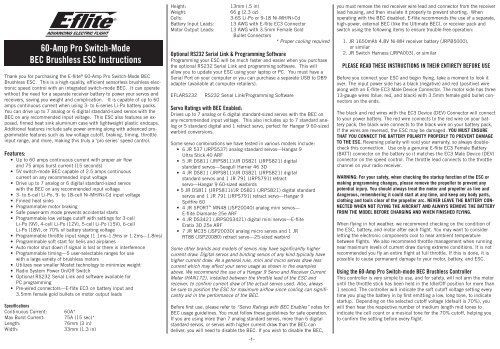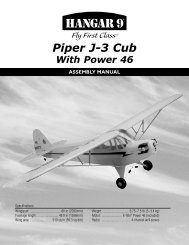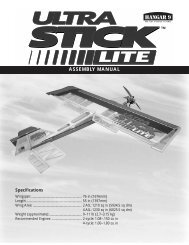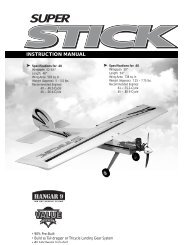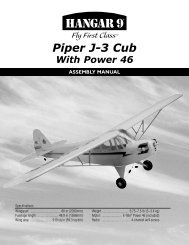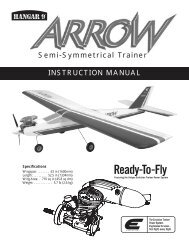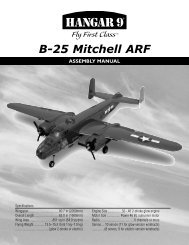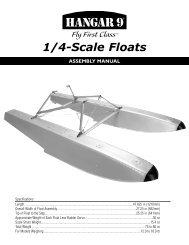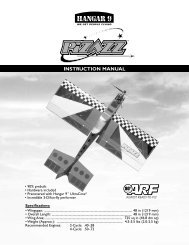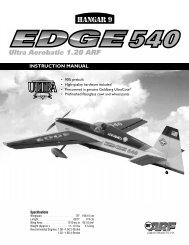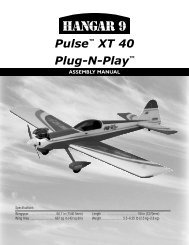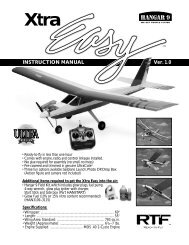60-Amp Pro Switch-Mode BEC Brushless ESC Instructions - Robot ...
60-Amp Pro Switch-Mode BEC Brushless ESC Instructions - Robot ...
60-Amp Pro Switch-Mode BEC Brushless ESC Instructions - Robot ...
- No tags were found...
Create successful ePaper yourself
Turn your PDF publications into a flip-book with our unique Google optimized e-Paper software.
<strong>60</strong>-<strong>Amp</strong> <strong>Pro</strong> <strong>Switch</strong>-<strong>Mode</strong><strong>BEC</strong> <strong>Brushless</strong> <strong>ESC</strong> <strong>Instructions</strong>Thank you for purchasing the E-flite ® <strong>60</strong>-<strong>Amp</strong> <strong>Pro</strong> <strong>Switch</strong>-<strong>Mode</strong> <strong>BEC</strong><strong>Brushless</strong> <strong>ESC</strong>. This is a high-quality, efficient sensorless brushless electronicspeed control with an integrated switch-mode <strong>BEC</strong>. It can operatewithout the need for a separate receiver battery to power your servos andreceivers, saving you weight and complication. It is capable of up to <strong>60</strong>amps continuous current when using 3- to 6-series Li-Po battery packs.You can drive up to 7 analog or 6 digital standard-sized servos with the<strong>BEC</strong> on any recommended input voltage. This <strong>ESC</strong> also features an exposed,finned heat sink aluminum case with lightweight plastic endcaps.Additional features include safe power arming along with advanced programmablefeatures such as low voltage cutoff, braking, timing, throttleinput range, and more, making this truly a ‘pro series’ speed control.Features:• Up to <strong>60</strong> amps continuous current with proper air flowand 75 amps burst current (15 seconds)• 5V switch-mode <strong>BEC</strong> capable of 2.5 amps continuouscurrent on any recommended input voltage• Drive up to 7 analog or 6 digital standard-sized servoswith the <strong>BEC</strong> on any recommended input voltage• 3- to 6-cell Li-Po, 9- to 18-cell Ni-MH/Ni-Cd input voltage• Finned heat sinks• <strong>Pro</strong>grammable motor braking• Safe power-arm mode prevents accidental starts• <strong>Pro</strong>grammable low voltage cutoff with settings for 3-cellLi-Po (9V), 4-cell Li-Po (12V), 5-cell Li-Po (15V), 6-cellLi-Po (18V), or 70% of battery starting voltage• <strong>Pro</strong>grammable throttle input range (1.1ms–1.9ms or 1.2ms–-1.8ms)• <strong>Pro</strong>grammable soft start for helis and airplanes• Auto motor shut down if signal is lost or there is interference• <strong>Pro</strong>grammable timing—5 user-selectable ranges for usewith a large variety of brushless motors• Utilizes new smaller Mosfet technology to minimize weight• Radio System Power On/Off <strong>Switch</strong>• Optional RS232 Serial Link and software available forPC programming• Pre-wired connectors—E-flite EC3 on battery input and3.5mm female gold bullets on motor output leadsSpecificationsContinuous Current: <strong>60</strong>A*Max Burst Current: 75A (15 sec)*Length:76mm (3 in)Width:33mm (1.3 in)Height:Weight:Cells:Battery Input Leads:Motor Output Leads:13mm (.5 in)66 g (2.3 oz)3-6S Li-Po or 9-18 Ni-MH/Ni-Cd13 AWG with E-flite EC3 Connector13 AWG with 3.5mm Female GoldBullet Connectors* <strong>Pro</strong>per cooling requiredOptional RS232 Serial Link & <strong>Pro</strong>gramming Software<strong>Pro</strong>gramming your <strong>ESC</strong> will be much faster and easier when you purchasethe optional RS232 Serial Link and programming software. This willallow you to update your <strong>ESC</strong> using your laptop or PC. You must have aSerial Port on your computer or you can purchase a separate USB to DB9adapter (available at computer retailers).EFLARS232RS232 Serial Link/<strong>Pro</strong>gramming SoftwareServo Ratings with <strong>BEC</strong> Enabled:Drives up to 7 analog or 6 digital standard-sized servos with the <strong>BEC</strong> onany recommended input voltage. This also includes up to 7 standard analogor 5 standard digital and 1 retract servo, perfect for Hangar 9 <strong>60</strong>-sizedwarbird conversions.Some servo combinations we have tested in various models include:• 6 JR 537 (JRPS537) analog standard servos—Hangar 9Ultra Stick 40 ARF• 5 JR DS811 (JRPS811)/JR DS821 (JRPS821) digitalstandard servos—Seagull Harrier 46 3D• 4 JR DS811 (JRPS811)/JR DS821 (JRPS821) digitalstandard servos and 1 JR 791 (JRPS791) retractservo—Hangar 9 <strong>60</strong>-sized warbirds• 5 JR DS811 (JRPS811)/JR DS821 (JRPS821) digital standardservos and 1 JR 791 (JRPS791) retract servo—Hangar 9Spitfire <strong>60</strong>• 4 JR SPORT MN48 (JSP20040) analog mini servos—E-flite Diamante 25e ARF• 4 JR DS3421 (JRPSDS3421) digital mini servos—E-fliteEratix 3D 25e ARF• 7 JR MC35 (JSP20030) analog micro servos and 1 JRRT88 (JSP20080) retract servo—25-sized warbirdSome other brands and models of servos may have significantly highercurrent draw. Digital servos and binding servos of any kind typically havehigher current draw. As a general rule, mini and micro servos draw lesscurrent which may affect your servo usage as shown in the examplesabove. We recommend the use of a Hangar 9 Servo and Receiver CurrentMeter (HAN172), installed between the throttle lead of the <strong>ESC</strong> andreceiver, to confirm current draw of the actual servos used. Also, alwaysbe sure to position the <strong>ESC</strong> for maximum airflow since cooling can significantlyaid in the performance of the <strong>BEC</strong>.Before first use, please refer to “Servo Ratings with <strong>BEC</strong> Enables” notes for<strong>BEC</strong> usage guidelines. You must follow these guidelines for safe operation.If you are using more than 7 analog standard servos, more than 6 digitalstandard servos, or servos with higher current draw than the <strong>BEC</strong> candeliver, you will need to disable the <strong>BEC</strong>. If you wish to disable the <strong>BEC</strong>,-1-you must remove the red receiver wire lead and connector from the receiverlead housing, and then insulate it properly to prevent shorting. Whenoperating with the <strong>BEC</strong> disabled, E-flite recommends the use of a separate,high-power, external <strong>BEC</strong> (like the Ultimate <strong>BEC</strong>), or receiver pack andswitch using the following items to ensure trouble-free operation:1. JR 1650mAh 4.8V Ni-MH receiver battery (JRPB5000),or similar2. JR <strong>Switch</strong> Harness (JRPA003), or similarPLEASE READ THESE INSTRUCTIONS IN THEIR ENTIRETY BEFORE USEBefore you connect your <strong>ESC</strong> and begin flying, take a moment to look itover. The input power side has a black (negative) and red (positive) wirealong with an E-flite EC3 Male Device Connector. The motor side has three13-gauge wires (blue, red, and black) with 3.5mm female gold bullet connectorson the ends.The black and red wires with the EC3 Device (DEV) Connector will connectto your power battery. The red wire connects to the red wire on your batterypack, the black wire connects to the black wire on your battery pack.If the wires are reversed, the <strong>ESC</strong> may be damaged. YOU MUST ENSURETHAT YOU CONNECT THE BATTERY POLARITY PROPERLY TO PREVENT DAMAGETO THE <strong>ESC</strong>. Reversing polarity will void your warranty, so always doublecheckthis connection. Use only a genuine E-flite EC3 Female Battery(BATT) connector on the battery so it matches the EC3 Male Device (DEV)connector on the speed control. The throttle lead connects to the throttlechannel on your radio receiver.WARNING: For your safety, when checking the startup function of the <strong>ESC</strong> ormaking programming changes, please remove the propeller to prevent anypotential injury. You should always treat the motor and propeller as live anddangerous, remembering it could start at any time, and keep any body parts,clothing and tools clear of the propeller arc. NEVER LEAVE THE BATTERY CON-NECTED WHEN NOT FLYING THE AIRCRAFT AND ALWAYS REMOVE THE BATTERYFROM THE MODEL BEFORE CHARGING AND WHEN FINISHED FLYING.When flying in hot weather, we recommend checking on the condition ofthe <strong>ESC</strong>, battery, and motor after each flight. You may want to considerletting the electronic components cool to near ambient temperaturebetween flights. We also recommend throttle management when runningnear maximum levels of current draw during extreme conditions. It is notrecommended you fly an entire flight at full throttle. If this is done, it ispossible to cause permanent damage to your motor, battery, and <strong>ESC</strong>.Using the <strong>60</strong>-<strong>Amp</strong> <strong>Pro</strong> <strong>Switch</strong>-mode <strong>BEC</strong> <strong>Brushless</strong> ControllerThis controller is very simple to use, and for safety, will not arm the motoruntil the throttle stick has been held in the Idle/Off position for more than1 second. The controller will indicate the soft cutoff voltage setting everytime you plug the battery in by first emitting a low, long tone, to indicatestartup. Depending on the selected cutoff voltage (default is 70%), youwill then hear the respective number of medium length mid tones toindicate the cell count or a musical tone for the 70% cutoff, helping youto confirm the setting before every flight.
Radio System Power <strong>Switch</strong>The <strong>ESC</strong> is equipped with an On/Off switch intended to cycle the power toyour receiver/radio system on and off. This helps to prevent the radio systemfrom being powered on and arming the <strong>ESC</strong> prematurely (before you areready) when the battery is plugged in, making it safer and more convenientto handle the model before (and after) flight.However, the On/Off switch is for short-term use only (like when you areat the field). This is because even if the switch is in the off position, whenthe battery is connected, some power is still being consumed by the <strong>ESC</strong>.It is critical that you always disconnect the battery from the <strong>ESC</strong> when youare done flying, when you are traveling to and from your flying destination,and when the model is being stored. Leaving the battery plugged into the<strong>ESC</strong> for an extended period of time, even with the switch in the off position,could cause permanent damage to your battery as a result of overdischarging(especially if you are using a Li-Po battery).Connecting the <strong>ESC</strong> to the MotorThe three wires from your motor connect to the three female gold bulletconnectors on the <strong>ESC</strong>. The order of connection to the motor is not important;you can plug any motor wire into any connector. When you test thesystem, the motor runs backwards, you can simply unplug and switch anytwo of the motor wire plugs connected to the <strong>ESC</strong>.Mounting the <strong>ESC</strong>Choose a location that has good airflow and offers good protection. Thesmooth section on the bottom of the heat sink case is designed to acceptadhesive-backed hook and loop or 2-sided tape. Do not cover the top of theheat sinks as this will greatly reduce their effectiveness. Mount the <strong>ESC</strong>with a combination of hook and loop, 2-sided foam tape, and/or tie wraps.Starting Your Power System1. Turn on your transmitter and ensure the position of thethrottle stick is set to Idle/Off.2. Plug the battery pack into the controller. You will hear 1 low long toneto indicate startup, then the respective number of medium-length midtones to indicate the cell count or a musical tone for the 70% cutoff,followed by 3 rising tones to indicate the controller is armed.3. When you move the throttle stick upward, the motor will run. If youcontinue to move the throttle stick upward to the full throttle (highposition), the motor will run faster. If you lower the throttle stick belowthe start-up position, the motor will stop running.4. Check servo motion as part of your preflight check. It is veryimportant you make sure linkages are free-moving with no binding.Remember, when in the programming mode:Full Throttle = Stick UpIdle = Stick DownThe default settings (from the package) for your E-flite <strong>60</strong>-<strong>Amp</strong> <strong>Pro</strong><strong>ESC</strong> are as follows:• Voltage cutoff set at 70%• Brake set to Off• Timing set at 15 degrees• Throttle Input Range set at 1.2ms to 1.8ms• Start-up Rate (Acceleration Delay) set at 0.25 seconds• PWM Frequency set at 8kHz• Operating <strong>Mode</strong> set to normal (airplane)Entering the <strong>Pro</strong>gramming <strong>Mode</strong>1. With the battery disconnected from the controller, and the transmitterturned on, first move the throttle stick to full throttle (>1.7ms)position. Leave it in this position and then connect the battery to thecontroller.2. Wait for 5 seconds, and the <strong>ESC</strong> will give two sets of fast ringing tonesto indicate you have successfully entered the programming mode.3. Once you hear these tones, move the stick to center (between 1.4 and1.7ms) for 5 seconds, and the controller will beep 1 time, indicatingyou are now in Menu 1.4. The controller will now wait 5 seconds for you to make your selection;your programming options are either full throttle (>1.7ms) or idle(1.7ms)position. You will have 5 seconds to make your selection.7. If you want to advance to the next menu, allow the programming toskip to the next menu after the 5 seconds have expired.<strong>Pro</strong>gramming Menu 1 – Voltage CutoffUse this option to set the voltage at which the controller will shut downthe motor to prevent damage to your battery when it reaches the cutoffvoltage. You will know your battery pack has reached auto cutoff whenyou hear the motor “pulse” repeatedly.1. Move the throttle stick to full throttle (>1.7ms) position tomake changes to the voltage cutoff programming.a. To select 3-cell low voltage cutoff – You will hear 3 shortbeeps. Move the throttle stick to center (between 1.4 and1.6ms). The controller will beep 2 times, indicating youhave set the program selection or leave in full throttle for5 seconds to advance to the next selection.b. To select 4-cell low voltage cutoff – You will hear 4 shortbeeps. Move the throttle stick to center (between 1.4 and1.6ms). The controller will beep 2 times, indicating youhave set the program selection or leave in full throttle for5 seconds to advance to the next selection.c. To select 5-cell low voltage cutoff – You will hear 5 short-2-beeps. Move the throttle stick to center (between 1.4 and1.6ms). The controller will beep 2 times, indicating youhave set the program selection or leave in full throttle for5 seconds to advance to the next selection.d. To select 6-cell low voltage cutoff – You will hear 6 shortbeeps. Move the throttle stick to center (between 1.4 and1.6ms). The controller will beep 2 times, indicating youhave set the program selection or leave in full throttle for5 seconds to advance to the next selection.e. To select 70% cutoff – You will hear 7 short beeps. Movethe throttle stick to center (between 1.4 and 1.6ms). Thecontroller will beep 2 times, indicating you have set theprogram selection or leave in full throttle for 5 seconds toadvance to the first selection again.IMPORTANT NOTE ABOUT 70% CUTOFF: This option will activate the softcutoff at 70% of startup voltage. For example, if your pack measures 15.0 voltsat startup, then the soft cut will occur at 10.5 volts. The 70% cutoff option willcheck the startup voltage every time you plug the battery into the controller,so beware of using partially charged packs, as the system cannot protect yourLi-Po batteries if you are using the 70% cutoff and connect a partially chargedpack. You will know your battery pack has reached soft auto cutoff when youhear the motor “pulse” repeatedly. We recommend you land your model assoon as you hear the motor pulse (indicating the pack voltage has dropped tothe cutoff voltage level) to prevent over-discharge of the Li-Po battery pack, andto prevent sudden power loss.<strong>Pro</strong>gramming Menu 2 – Brake TypeThe default setting is Brake Off. This option gives you the choice to havethe <strong>ESC</strong> stop the propeller during flight (Brake On) or allow it to windmill(Brake Off). Use the Brake On options for folding propellers.1. Move the stick to center (between 1.4 and 1.6ms) for 5 seconds, andthe controller will beep 2 times, indicating you are now in Menu 2.2. Move the throttle stick to full throttle (>1.7ms) position tomake changes to the Brake Type programming.a. To select No Brake/Brake Off – You will hear 1 short beep.Move the throttle stick to center (between 1.4 and1.6ms). The controller will beep 2 times, indicating youhave set the program selection or leave in full throttle for5 seconds to advance to the next selection.b. To select Soft Brake – You will hear 2 short beeps. Movethe throttle stick to center (between 1.4 and 1.6ms).The controller will beep 2 times, indicating you have setthe program selection or leave in full throttle for 5seconds to advance to the next selection.c. To select Medium Brake – You will hear 3 short beeps.Move the throttle stick to center (between 1.4 and1.6ms). The controller will beep 2 times, indicating youhave set the program selection or leave in full throttle for5 seconds to advance to the next selection.d. To select Hard Brake – You will hear 4 short beeps. Movethe throttle stick to center (between 1.4 and 1.6ms). Thecontroller will beep 2 times, indicating you have set theprogram selection or leave in full throttle for 5 seconds to
advance to the first selection again.<strong>Pro</strong>gramming Menu 3 – TimingThe default setting is 15 degrees. As a general rule, lower pole countmotors use lower timing and higher pole count motors use higher timing.Please refer to your motor instructions and specifications for an indicationof the number of poles.Low Timing AdvanceTiming Degrees – 5 & 10Motor Poles – 2 to 4Expected Performance – Good balance of power and efficiencyMotor Poles – 6 or moreExpected Performance – Best efficiency and run time (lowest power)Standard Timing AdvanceTiming Degrees – 15 & 20Motor Poles – 6 to 12Expected Performance – Good balance of power and efficiencyMotor Poles – 14 or moreExpected Performance – Best efficiency and run time (lowest power)High Timing AdvanceTiming Degrees – 25Motor Poles – 12Expected Performance – Highest power, less efficiencyMotor Poles – 14 or moreExpected Performance – Good balance of power and efficiency1. Move the stick to center (between 1.4 and 1.6ms) for 5 seconds, andthe controller will beep 3 times, indicating you are now in Menu 3.2. Move the throttle stick to full throttle (>1.7ms) position to makechanges to the Timing programming.a. To select 5 Degrees – You will hear 1 short beep. Movethe throttle stick to center (between 1.4 and 1.6ms). Thecontroller will beep 2 times, indicating you have set theprogram selection or leave in full throttle for 5 seconds toadvance to the next selection.b. To select 10 Degrees – You will hear 2 short beeps.Move the throttle stick to center (between 1.4 and1.6ms). The controller will beep 2 times, indicating youhave set the program selection or leave in full throttle for5 seconds to advance to the next selection.c. To select 15 Degrees – You will hear 3 short beeps.Move the throttle stick to center (between 1.4 and1.6ms). The controller will beep 2 times, indicating youhave set the program selection or leave in full throttle for5 seconds to advance to the next selection.d. To select 20 Degrees – You will hear 4 short beeps.Move the throttle stick to center (between 1.4 and1.6ms). The controller will beep 2 times, indicating youhave set the program selection or leave in full throttle for5 seconds to advance to the next selection.e. To select 25 Degrees – You will hear 5 short beeps.Move the throttle stick to center (between 1.4 and1.6ms). The controller will beep 2 times, indicating youhave set the program selection or leave in full throttle for5 seconds to advance to the first selection again.<strong>Pro</strong>gramming Menu 4 – Throttle Input Range (PWM)The default setting is 1.2ms to 1.8ms and should work with most radiosystems. This option allows for proper throttle input with many differentradio systems. However, some radios have a wider output range, and maygive a more linear response with the 1.1ms to 1.9ms range. If you feelthere is too much “dead” area in the stick movement near full throttle, tryadjusting the end points in your radio, or change to the wider input range.Be aware that if these settings are not correct, it may be impossible toarm the controller.1. Move the stick to center (between 1.4 and 1.6ms) for 5 seconds, andthe controller will beep 4 times, indicating you are now in Menu 4.2. Move the throttle stick to full throttle (>1.7ms) position to makechanges to the Throttle Input Range programming.a. To select 1.2ms to 1.8ms – You will hear 1 short beep.Move the throttle stick to center (between 1.4 and1.6ms). The controller will beep 2 times, indicating youhave set the program selection or leave in full throttle for5 seconds to advance to the next selection.b. To select 1.1ms to 1.9ms – You will hear 2 short beeps.Move the throttle stick to center (between 1.4 and1.6ms). The controller will beep 2 times, indicating youhave set the program selection or leave in full throttle for5 seconds to advance to the first selection again.<strong>Pro</strong>gramming Menu 5 – Start-Up RateThe default setting is 0.25 seconds. The start-up rate is the time it takesto reach maximum motor speed. Changing the setting to 1 second can beuseful with power-fragile gear boxes.1. Move the stick to center (between 1.4 and 1.6ms) for 5 seconds, andthe controller will beep 5 times, indicating you are now in Menu 3.2. Move the throttle stick to full throttle (>1.7ms) position to makechanges to the Start-up Rate programming.a. To select .25 second – You will hear 1 short beep. Movethe throttle stick to center (between 1.4 and 1.6ms). Thecontroller will beep 2 times, indicating you have set theprogram selection or leave in full throttle for 5 seconds toadvance to the next selection.b. To select 1 second – You will hear 2 short beeps. Movethe throttle stick to center (between 1.4 and 1.6ms). Thecontroller will beep 2 times, indicating you have set theprogram selection or leave in full throttle for 5 seconds toadvance to the first selection again.-3-<strong>Pro</strong>gramming Menu 6 – PWM <strong>Switch</strong>ing FrequencyThe default setting is 8kHz, which should be acceptable for most motors.If you have a low or very low inductance motor and know you need to usea higher PWM Frequency (refer to the manual included with the motor),then you can change the setting. Otherwise, we recommend leaving thedefault setting.1. Move the stick to center (between 1.4 and 1.6ms) for 5 seconds, andthe controller will beep 6 times, indicating you are now in Menu 6.2. Move the throttle stick to full throttle (>1.7ms) position to makechanges to the PWM <strong>Switch</strong>ing Frequency programming.a. To select 8kHz PWM Frequency – You will hear 1 short beep.Move the throttle stick to center (between 1.4 and 1.6ms).The controller will beep 2 times, indicating you have set theprogram selection or leave in full throttle for 5 seconds toadvance to the next selection.b. To select 16kHz PWM Frequency – You will hear 2 shortbeeps. Move the throttle stick to center (between 1.4 and1.6ms). The controller will beep 2 times, indicating youhave set the program selection or leave in full throttle for 5seconds to advance to the next selection.c. To select 32kHz PWM Frequency – You will hear 3 shortbeeps. Move the throttle stick to center (between 1.4 and1.6ms). The controller will beep 2 times, indicating youhave set the program selection or leave in full throttle for 5seconds to advance to the first selection again.<strong>Pro</strong>gramming Menu 7 – Operating <strong>Mode</strong>The default setting is set to Normal (airplane) <strong>Mode</strong>, which is limited toa start-up rate of 0.25 or 1 second. Alternatively, the Heli <strong>Mode</strong> can beselected which reduces the start-up rate to 5-seconds for the first start-upand any start-up after the motor/<strong>ESC</strong> has been stopped for more than 5seconds. This helps to prevent damaging the motor, gears or any othercomponents from an abrupt start-up when none of the parts are moving.Any time the motor/<strong>ESC</strong> has been stopped for less than 5 seconds in Heli<strong>Mode</strong>, the start-up will be immediate. This allows power to be applied immediately,such as when aborting an auto-rotation attempt or for any otherreason, to help prevent a crash. Remember, you must wait more than 5seconds after stopping the motor/<strong>ESC</strong> in order for the 5 second start-up tooccur again.1. Move the stick to center (between 1.4 and 1.6ms) for 5 seconds, andthe controller will beep 7 times, indicating you are now in Menu 7.2. Move the throttle stick to full throttle (>1.7ms) position to makechanges to the Operating <strong>Mode</strong> programming.a. To select Normal <strong>Mode</strong> – You will hear 1 shortbeep. Move the throttle stick to center (between 1.4 and1.6ms). The controller will beep 2 times, indicating youhave set the program selection or leave in full throttle for5 seconds to advance to the next selection.b. To select Heli <strong>Mode</strong> – You will hear 2short beeps. Move the throttle stick to center (between
1.4 and 1.6ms). The controller will beep 2 times, indicating youhave set the program selection or leave in full throttle for 5 secondsto advance to the first selection again.TroubleshootingThe controller will beep more quietly than normal if the input voltage isbelow the cutoff voltage when the battery is connected. Check the voltageof the battery pack to see if it is correct (charged), or the programmedcutoff setting if the input voltage is set incorrectly for the voltage of thepack being used.If you have trouble arming the controller (and the throttle trim has beenset to minimum), enter the programming mode and try changing the settingto 1.1ms to 1.9ms in <strong>Pro</strong>gramming Menu 4 to see if it helps correctthe problem. If it is a computer radio, you may alternatively increase highand low throttle ATV (endpoint) percentages.Note: Increasing the high ATV will not have a consequence on armingissues, only low ATV.Some transmitters, including all Futaba transmitters, will require thethrottle channel to be “reversed” for proper operation.Warranty periodHorizon Hobby, Inc., (Horizon) warranties that the <strong>Pro</strong>ducts purchased(the “<strong>Pro</strong>duct”) will be free from defects in materials and workmanshipfor a period of 1 year from the date of purchase by the Purchaser.Limited Warranty(a) This warranty is limited to the original Purchaser (“Purchaser”) andis not transferable. REPAIR OR REPLACEMENT AS PROVIDED UNDERTHIS WARRANTY IS THE EXCLUSIVE REMEDY OF THE PURCHASER.This warranty covers only those <strong>Pro</strong>ducts purchased from an authorizedHorizon dealer. Third party transactions are not covered by this warranty.<strong>Pro</strong>of of purchase is required for warranty claims. Further, Horizonreserves the right to change or modify this warranty without notice anddisclaims all other warranties, express or implied.(b) Limitations- HORIZON MAKES NO WARRANTY OR REPRESENTA-TION, EXPRESS OR IMPLIED, ABOUT NONINFRINGEMENT, MER-CHANTABILITY OR FITNESS FOR A PARTICULAR PURPOSE OF THEPRODUCT. THE PURCHASER ACKNOWLEDGES THAT THEY ALONHAVE DETERMINED THAT THE PRODUCT WILL SUITABLY MEET THEREQUIREMENTS OF THE PURCHASER’S INTENDED USE.(c) Purchaser Remedy- Horizon’s sole obligation here under 8 shall bethat Horizon will, at its option, (i) repair or (ii) replace, any <strong>Pro</strong>ductdetermined by Horizon to be defective. In the event of a defect, these arethe Purchaser’s exclusive remedies. Horizon reserves the right to inspectany and all equipment involved in a warranty claim. Repair or replacementdecisions are at the sole discretion of Horizon. This warranty does notcover cosmetic damage or damage due to acts of God, accident, misuse,abuse, negligence, commercial use, or modification of or to any part of the<strong>Pro</strong>duct. This warranty does not cover damage due to improper installation,operation, maintenance, or attempted repair by anyone other thanHorizon. Return of any goods by Purchaser must be approved in writingby Horizon before shipment.Damage LimitsHORIZON SHALL NOT BE LIABLE FOR SPECIAL, INDIRECT OR CON-SEQUENTIAL DAMAGES, LOSS OF PROFITS OR PRODUCTION ORCOMMERCIAL LOSS IN ANY WAY CONNECTED WITH THE PRODUCT,WHETHER SUCH CLAIM IS BASED IN CONTRACT, WARRANTY, NEG-LIGENCE, OR STRICT LIABILITY. Further, in no event shall the liabilityof Horizon exceed the individual price of the <strong>Pro</strong>duct on which liabilityis asserted. As Horizon has no control over use, setup, final assembly,modification or misuse, no liability shall be assumed nor accepted forany resulting damage or injury. By the act of use, setup or assembly, theuser accepts all resulting liability. If you as the Purchaser or user are notprepared to accept the liability associated with the use of this <strong>Pro</strong>duct,you are advised to return this <strong>Pro</strong>duct immediately in new and unusedcondition to the place of purchase.Law: These Terms are governed by Illinois law (without regard to conflictof law principals).Safety PrecautionsThis is a sophisticated hobby <strong>Pro</strong>duct and not a toy. It must be operatedwith caution and common sense and requires some basic mechanicalability. Failure to operate this <strong>Pro</strong>duct in a safe and responsible mannercould result in injury or damage to the <strong>Pro</strong>duct or other property. This<strong>Pro</strong>duct is not intended for use by children without direct adult supervision.The product manual contains instructions for safety, operation andmaintenance. It is essential to read and follow all the instructions andwarnings in the manual, prior to assembly, setup or use, in order tooperate correctly and avoid damage or injury.Questions, Assistance, and RepairsYour local hobby store and/or place of purchase cannot provide warrantysupport or repair. Once assembly, setup or use of the <strong>Pro</strong>duct has beenstarted, you must contact Horizon directly. This will enable Horizon tobetter answer your questions and service you in the event that you mayneed any assistance. For questions or assistance, please direct your emailto productsupport@horizonhobby.com, or call 877.504.0233 toll free tospeak to a service technician.Inspection or RepairsIf this <strong>Pro</strong>duct needs to be inspected or repaired, please call for a ReturnMerchandise Authorization (RMA). Pack the <strong>Pro</strong>duct securely using ashipping carton. Please note that original boxes may be included, butare not designed to withstand the rigors of shipping without additionalprotection. Ship via a carrier that provides tracking and insurance for lostor damaged parcels, as Horizon is not responsible for merchandise until itarrives and is accepted at our facility. A Service Repair Request is availableat www.horizonhobby.com on the “Support” tab. If you do not haveinternet access, please include a letter with your complete name, streetaddress, email address and phone number where you can be reached-4-during business days, your RMA number, a list of the included items,method of payment for any non warranty expenses and a brief summary ofthe problem. Your original sales receipt must also be included for warrantyconsideration. Be sure your name, address, and RMA number are clearlywritten on the outside of the shipping carton.Warranty Inspection and RepairsTo receive warranty service, you must include your original sales receiptverifying the proof-of-purchase date. <strong>Pro</strong>vided warranty conditions havebeen met, your <strong>Pro</strong>duct will be repaired or replaced free of charge. Repairor replacement decisions are at the sole discretion of Horizon Hobby.Non-Warranty RepairsShould your repair not be covered by warranty the repair will be completedand payment will be required without notification or estimate of theexpense unless the expense exceeds 50% of the retail purchase cost. Bysubmitting the item for repair you are agreeing to payment of the repairwithout notification. Repair estimates are available upon request. Youmust include this request with your repair. Non-warranty repair estimateswill be billed a minimum of ½ hour of labor. In addition you will be billedfor return freight. Please advise us of your preferred method of payment.Horizon accepts money orders and cashiers checks, as well as Visa,MasterCard, American Express, and Discover cards. If you choose to payby credit card, please include your credit card number and expirationdate. Any repair left unpaid or unclaimed after 90 days will be consideredabandoned and will be disposed of accordingly. Please note: non-warrantyrepair is only available on electronics and model engines.Electronics and engines requiring inspection or repair should be shippedto the following address:Horizon Service Center4105 Fieldstone RoadChampaign, Illinois 61822All other <strong>Pro</strong>ducts requiring warranty inspection or repair should beshipped to the following address:Horizon <strong>Pro</strong>duct Support4105 Fieldstone RoadChampaign, Illinois 61822Please call 877-504-0233 with any questions or concerns regarding thisproduct or warranty.© 2007 Horizon Hobby, Inc.www.horizonhobby.comwww.E-fliteRC.comE-flite® is an exclusive brand of Horizon Hobby, Inc.Made in China10773.1


